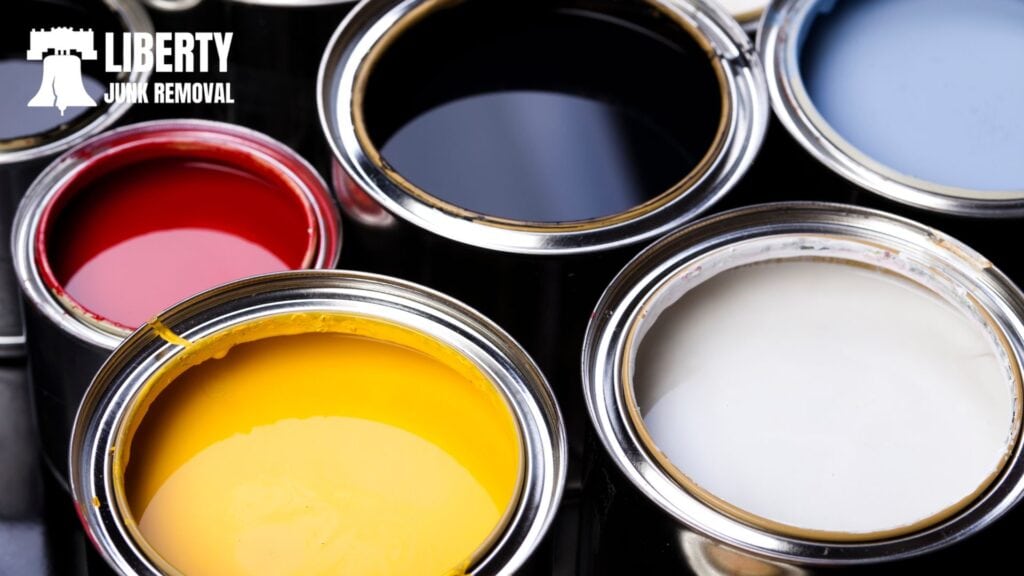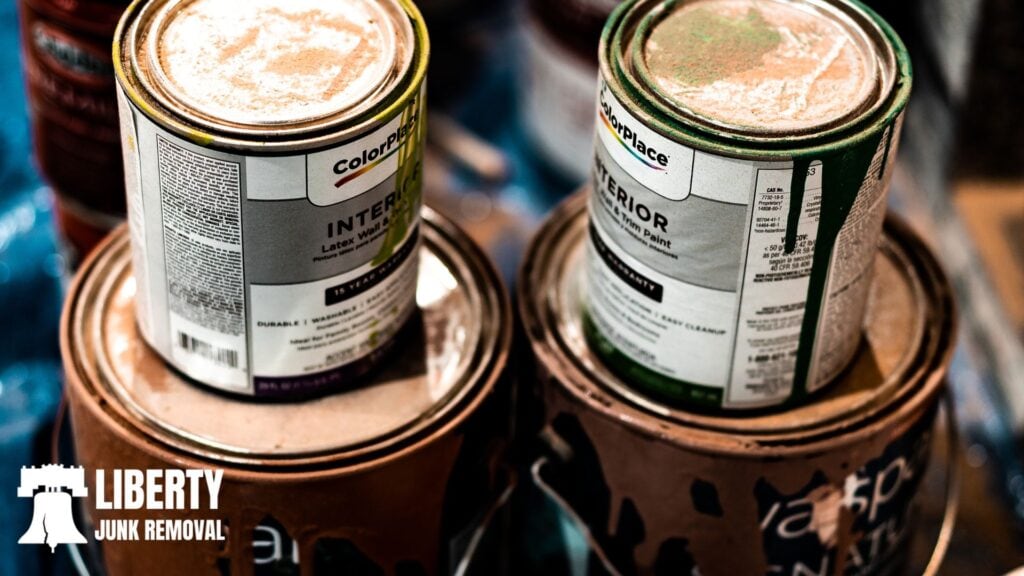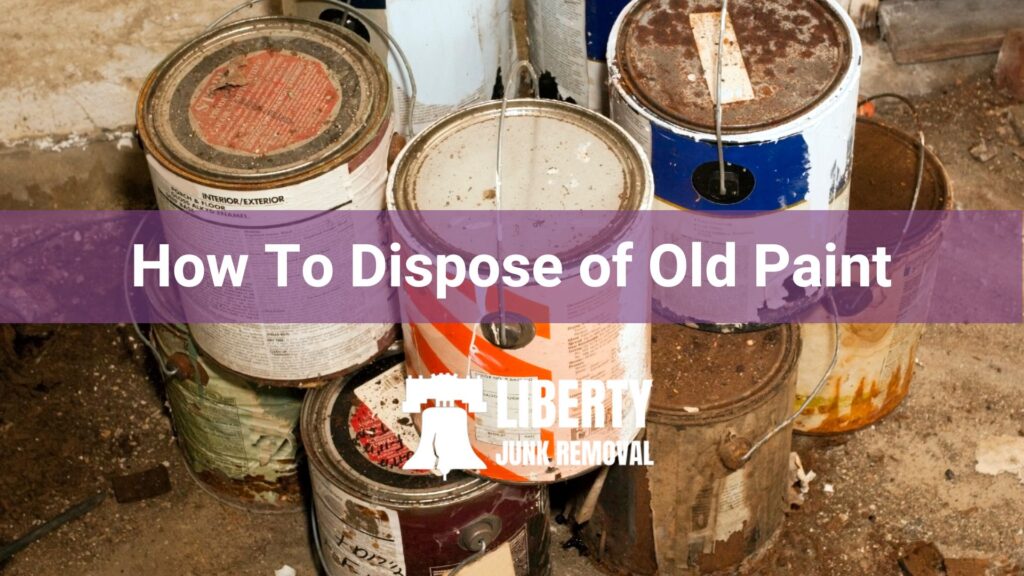Stuck with old paint cans in your garage? Different paints need different disposal techniques. Dry out water-based paints by leaving them open in a ventilated area or adding absorbents. Oil-based paints should be taken to hazardous waste sites.
Discover more eco-friendly answers to “How to dispose of old paint?” in our comprehensive guide.
Understanding Paint Types for Disposal
Disposing of old paint is more than a simple cleanup task. Knowing how to handle different types of paint, particularly water-based paints like latex and acrylic, is crucial for eco-friendly disposal.
Water-Based Paints
As the name suggests, use water as a solvent to hold the pigment and binder. This characteristic makes them less hazardous compared to oil-based paints. Typically, water-based paints are acrylic or latex-based and are popular due to their ease of use and cleanup. However, their disposal needs to be handled thoughtfully to prevent environmental harm.
Safe Disposal Methods:
1. Dry It Out
For small amounts of water-based paint, the simplest disposal method is to let it dry out. This can be done by leaving the paint can open in a well-ventilated area. For larger quantities, adding absorbent materials like kitty litter, sawdust, or commercial paint hardeners can speed up the process. Once the paint has solidified, it’s much safer for disposal.
2. Regular Trash Disposal
Once the paint is completely dried, it can usually be disposed of with your regular household trash. However, it’s important to ensure that the paint is entirely solidified, as liquid paint can cause significant problems in waste management systems.
3. Recycle or Reuse
Before you decide to throw away leftover paint, consider recycling or reusing it. Many communities have paint recycling programs, and you can also donate usable paint to local organizations or use it for smaller projects.
Although water-based paints are generally considered non-hazardous, they can still impact the environment if not disposed of correctly. Avoid pouring leftover paint down the drain or into the ground.
Oil-based Paints
These paints are known for their smooth texture and richer color hues due to their darker pigments. However, they also release volatile organic compounds (VOCs), which can be harmful to both the environment and human health.
How to Identify Oil-Based Paints
- Check the Label: Oil-based paints usually require cleaning with turpentine or paint thinner, distinguishing them from water-based paints.
- Texture and Smell: They are smoother to the touch compared to water-based paints and have a stronger odor.
- Solvent Test: A spot test with a solvent like acetone can help identify the paint type. If the color does not bleed onto a rag when dabbed with the solvent, it’s likely oil-based.
Disposal of Oil-based Paints
- Hazardous Waste: Since oil-based paints are considered hazardous, they must be disposed of at a hazardous waste collection site. These paints cannot be simply thrown in the trash or poured down a drain.
- Dry It Out: If disposal isn’t immediately possible, let the paint dry out in a well-ventilated area. Absorbent materials like cat litter or sawdust can be mixed into the paint to speed up the drying process. Ensure the paint is fully dried before disposing of it.
- Donation: Unused oil paints can be donated to institutions like schools, art studios, or community centers. However, it’s essential to confirm they accept such donations.
- Paint Hardeners: You can use commercial or DIY paint hardeners to solidify oil-based paint for safer disposal.
- Recycling: Some specialized facilities recycle oil paint, but it’s not as common due to the complex process involved. Check with local waste management or recycling centers for options.
- Professional Disposal: Giving oil-based paint to professional painters or hazardous waste disposal services ensures safe and legal disposal. These experts can manage the paint by following environmental guidelines.
Specialty Paints (Acrylic, Latex)
Sorting and disposing of specialty paints such as acrylic and latex requires understanding their composition and the best practices for eco-friendly disposal.
Acrylic Paints
- Composition: Acrylic paints are based on chemical solutions of liquid plastic acrylic polymers and resins. They offer better UV protection and water resistance but usually contain more volatile organic compounds (VOCs).
- Handling and Storage: Follow the manufacturer’s instructions due to the higher VOC content. Store them away from heat and fire sources.
- Disposal: Once acrylic paint is completely dry, it can be thrown in the trash. For larger amounts, if reuse is not an option, consider taking it to a disposal facility. It’s important to note that while acrylics are water-based, they should not be poured down the drain as they can contain toxic chemicals that are difficult for water treatment plants to handle.
- Recycling: Acrylic paint is often recyclable. Check with your local recycling programs for options.
Latex Paints
Latex paints, which are also water-based, have lower VOCs and a composition that makes them user-friendly and simpler to dispose of:
- Handling and Storage: These paints require minimal safety gear, but be mindful of freezing temperatures as they can render the paint unusable.
- Disposal: Small amounts of latex paint can be dried out and disposed of in regular trash. Larger quantities should be taken to a disposal facility.
- Recycling: Some specialized facilities, like Acrylatex Coatings in California, recycle latex paint, turning it into new products, thus offering an eco-friendly disposal option.
Ideas for Repurposing Leftover Paint
Repurposing leftover paint is a great way to minimize waste and enhance your living space creatively.
Here are some innovative ideas of the things that you can give a makeover using leftover paint:
- Accent Walls or Designs: Use it to create an accent wall in a complementary color to the rest of the room. For smaller amounts, consider tape-off designs such as stripes or freehand patterns for a unique look.
- Trims and Doors: Refresh baseboards, window frames, door frames, or even doors themselves with leftover paint. This can add a pop of color or a sophisticated detail to your space.
- Cabinets and Drawers: Revitalize your kitchen, bathroom, or storage cabinets and drawers with a new hue. Consider painting the trim, just the upper or lower cabinets for a two-tone look, or even the backs of the cabinets for a subtle pop of color when opened.
- Furniture Makeover: Chairs, tables, and other furniture pieces can be transformed with a coat of paint. Focus on specific parts, like the legs or the top, for a unique touch.
- Floors: Painted floors or stenciled patterns can significantly change a room’s look. Consider faux rugs or stylish patterns for a bold statement.
- Murals and Artistic Creations: Unleash your creativity by painting a mural directly on the wall or on a canvas. This not only uses up paint but also adds a personal touch to your décor.
- Fireplaces: Give your fireplace a new lease of life with a fresh coat of paint. This can be a great project to prepare for the holiday season or brighten up the warmer months.
- Fabric Projects: Use spray paint to update outdoor rugs, doormats, curtains, or even lampshades. This idea is particularly effective for giving old fabrics a new look.
- Utensil Handles: Adding color to the handles of kitchen utensils can create a coordinated look in your kitchen. This small touch can make everyday items feel special.
- Picture Frames: Painting frames is a quick way to refresh mirrors or pictures, adding vibrancy and interest to your walls.
- Flower Pots: Personalize your garden by painting flower pots. This simple project can add color and character to your outdoor space.
- Repaint Old Furniture: Sand and prime an old piece of furniture before applying leftover paint. This can revitalize an outdated item without the need for a full replacement.
- Decorative Elements: Brighten up the interior of cabinets, the sides of drawers, or the back of a bookshelf with colorful paint. These small pops of color can make a big difference in a room.
- Front Door Makeover: The front door is an ideal canvas for leftover paint, creating a welcoming entrance to your home. Clean and prep the door thoroughly for the best results.
- Wall Decorations: Use stencils, create stripes, or even abstract art on your walls with leftover paint. This is a great way to add personality to your space without overwhelming it.
- Upcycle Neighbor’s Trash: Transform found items like curbside furniture, lamp bases, or wooden decorative pieces with a fresh coat of paint.
Guidelines for Recycling Paint Containers
Recycling paint containers involves a few key steps:
- Remove the lid from the paint can and pour the paint into another container if it’s not empty.
- Clean the paint can thoroughly; water-based paint can be recycled without additional cleaning, but oil-based paint cans need to be cleaned with mineral spirits.
- Once the paint cans are clean, they can be recycled. It’s important to note that many name-brand retailers offer recycling programs for paint containers.
Minimizing Paint Waste: Tips for Buying the Right Amount
Buying the right amount of paint is crucial to minimizing waste, both for cost efficiency and environmental reasons.
Here’s how you can make an informed purchase:
1. Calculate the Area
Start by measuring the square footage of the walls you plan to paint. Measure the height and width of each wall and multiply them to get the area. Remember to subtract the area of windows, doors, and any other spaces that don’t require painting.
2. Assess Paint Coverage
Paint cans usually have a coverage rate, indicating how much area they can cover per gallon. A common estimate is 350 square feet per gallon, but this can vary depending on the paint type and brand. Divide your total area by the coverage rate to determine how much paint you’ll need. If the can doesn’t specify, using the standard estimate of 350 square feet per gallon is a safe bet.
3. Factor in Color Changes and Surfaces
If you’re painting over a dark color with a lighter one, or vice versa, you may need additional coats. Textured walls also require more paint due to their increased surface area. Rough textures can require up to 50% more paint. For new, unprimed walls, remember that they absorb more paint, necessitating additional coats.

4. Use Primer
Primers can make a significant difference. A primer coat can reduce the number of paint coats needed, especially when making drastic color changes. Some retailers can tint the primer closer to your final paint color, further reducing the need for multiple paint coats.
5. Consult Paint Calculators
Many paint brands and home improvement stores offer online paint calculators. These tools consider factors like room dimensions, the number of doors and windows, and the paint type to give a more precise estimate. Remember, different calculators can yield different results, so it might be helpful to compare a few.
6. Learn About Return Policies
Some stores have return policies for unopened paint cans, allowing you to buy a little extra for safety without the worry of waste. If you end up not needing the extra cans, you can return them instead of figuring out how to dispose of them.
7. Store Leftover Paint Correctly
If you have leftover paint, store it properly for future use. Cover the opening with plastic wrap, seal the lid tightly, and store the can upside down at a moderate temperature to prevent freezing. This way, your paint remains usable for touch-ups or small projects.

Storage Tips for Extending the Life of Paint
Proper storage of paint is essential for extending its shelf life and ensuring it remains usable for future projects. Here’s how to store your paint effectively:
Choose the Right Location
Store your paint in a cool, dry place, like a basement or an interior closet. These locations typically maintain a consistent and moderate temperature, ideally between 50 and 75°F (10 and 24°C). This helps prevent the degradation of paint quality due to temperature fluctuations.
Avoid Certain Areas
Keep paint away from places that experience extreme temperatures, such as garages, attics, or outside sheds. Also, avoid storing paint near heating or air conditioning vents, as these can cause temperature shifts that ruin the paint.
Prevent Moisture Damage
Don’t store paint cans directly on concrete floors where they can absorb moisture. Instead, place them on shelves or pallets. Moisture can corrode metal cans and affect the quality of the paint.
Protect from Sunlight
Direct sunlight can prematurely age and degrade paint. Ensure that your storage area is not exposed to direct sunlight.
Airtight Sealing
Seal the paint can tightly to prevent air from entering and drying out the paint. For opened cans, placing a layer of plastic wrap under the lid before sealing can help achieve an airtight closure. Additionally, storing paint cans upside down creates an airtight seal and prevents skin from forming on the paint surface.
Use of Desiccant Packets
Including desiccant packets in the storage area can help absorb excess moisture from the air, keeping the paint dry and usable for longer.
Container Size Matters
If you have leftover paint, consider transferring it to a smaller, airtight container. This minimizes the air exposure, which can degrade the paint over time. The original paint cans are usually the best option for unopened paint, but for smaller amounts, suitable plastic or lined metal containers work well.
Monitor Paint’s Condition
Before reusing stored paint, inspect it for signs of spoilage, such as a strong odor, lumpy consistency, or poor color blending after stirring. If the paint has gone bad, it’s time to dispose of it following local hazardous waste guidelines.
Wrapping It Up: Paint Disposal Done Right
Let’s face it, disposing of old paint isn’t exactly a walk in the park, but it’s crucial. You’ve got the tools and tips now, from buying just enough paint and storing it like a pro to finally disposing of old paint responsibly when it’s past its prime.
If you’re doing a big cleanout project, we at Liberty Junk Removal have got your back. We’re not just some run-of-the-mill company; we’re a licensed and insured junk removal service in Philadelphia committed to responsible disposal. We believe in transparent, competitive pricing—no surprises, just honest work.
So, if you’ve got junk that needs to go, give us a call. Let’s keep things clean, green, and mean (in a good way!) together.







